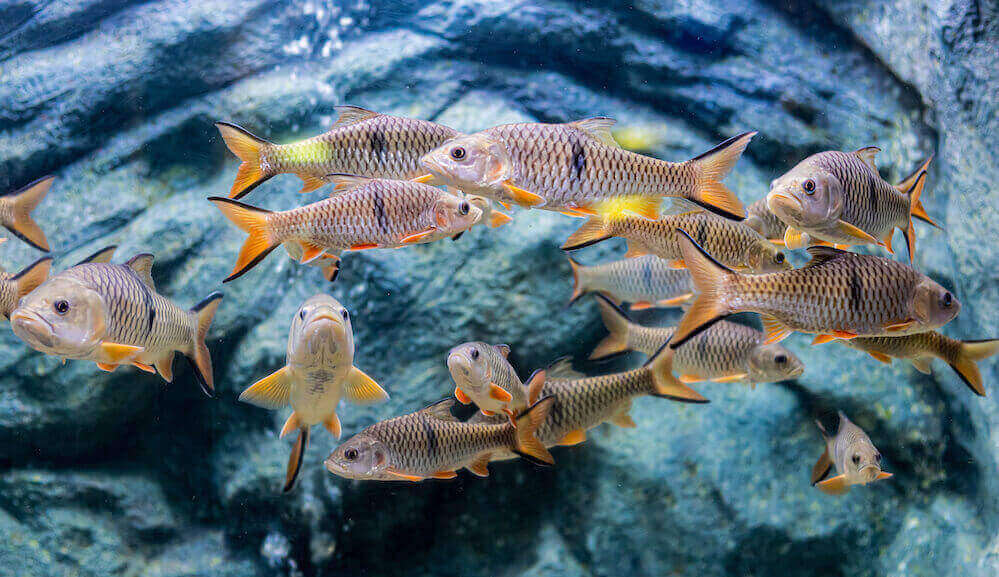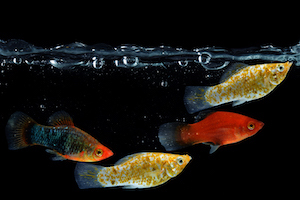
Can A Fish Drown?
You may have been thinking about how fish survive in a large body of water without getting drowned. A fish can not die from simply inhaling water, but a fish can die from suffocation. We will be explaining these claims in detail below.
For a fish to die through drowning, it means to die when submerged in water and inhaling water, which isn’t possible. But a fish can drown when a fish tank is overpopulated, and there is no enough dissolved oxygen and an excellent working filtration system.
A fish can also die when taking them out of the water, and they find it hard to breathe, but they can not die or drown when they’re submerged in water or inhale water.
Fish can only die from suffocation due to their inability to breathe and not from inhaling water.
Naturally, fish cannot drown because they can get oxygen from water. Unlike humans, fish do not have lungs, and they can take in as much water as possible without drowning. Therefore, if you’ve ever wondered if fish can drown, the answer is no.
Does a Fish Need Oxygen?

Of course, just like humans need oxygen, fish need it too! They need oxygen because it is very vital for them to survive in their environment. It helps them to respire and live like other living things.
Fish need oxygen because it helps them get and save energy from food. If the required amount of oxygen is not maintained, fish can die within a few minutes. Factors like sewage pollution, pump failure, thunderstorms, and the collapse of algae are the major factors that could lead to a fish’s death when there is no enough oxygen.
It would be best if you had oxygen to help your fish’s body to function properly. The cells in a fish’s body also require oxygen to stay healthy and perform actively.
When added with other substances, oxygen can also create new cell matter and protein and break down body waste products. The more they grow and multiply, the more oxygen a fish will need. However, fish do not require as much oxygen as humans because they are cold-blooded animals.
Other animals, especially warm-blooded, require additional oxygen to keep them hot. The primary cause of fish death is lack of oxygen, making them come to the surface gulping for air.
How Does a Fish Breathe Underwater?
As humans, we get our oxygen from the air. On the other hand, fish get their oxygen out of the water using their gills. The gills help them breathe when they take in water, pass it through the gill filaments, and absorb oxygen into the bloodstream. Then, the water comes out from the other side of the fish’s gills.
The gills have a group of cells that delivers deoxygenated blood through the arteries called the epithelium. It is feathery with lots of blood vessels.
During the process of taking in water by the fish, the fish force out the water through the gills. As the water passes across the epithelium membrane, the water’s dissolved oxygen is then taken in by the blood vessels and veins. During this time, the carbon dioxide produced through cell respiration is release.
Most fish have 4 gills on both sides of their body, and the gills have interlinked cell columns that control by a flap of skin that serves as a boundary between the gills and the mouth (operculum).
The fish reduces the lower part of their mouth, and the skin flaps get wide as a result, and the pressure in the mouth becomes lower than the outside to allow water inside.
When this happens, water gets forced out from the mouth via the operculum and across the gills.
The gills come in two types; the delicate and hard, whereby the hard type protects the delicate type. This protection is made possible by the tiny membranes on these gills and the wideness of the area. A few disadvantages come with this as the water’s oxygen level dissolved in water is lesser than the air’s amount of oxygen.
There is 21% oxygen or 210,000 parts per million of oxygen in the air. Water, on the other hand, has about 4-8 parts per million of oxygen. So, the gills need a much larger surface to thrive before getting enough energy supply from water due to the low amount of oxygen in the water.
A larger surface implies that the gills have to contact enough water to help the oxygen easily diffuse. Fish are cold-blooded and do not need a high amount of oxygen, and they also have a slow rate of metabolism than warm-blooded animals.
It implies that fish’s activity level and response rate depending on the surrounding temperature, making their metabolism rate drop drastically in colder months.
Depending on the type of water they live in, a fish also needs some particular organs. For instance, fish that live in freshwater need to keep enough salt in their body, while saltwater fish will have to remove too much salt from their body to enable them to survive.
What Could Make a Fish Suffocate?
As stated earlier, a fish can only suffocate when oxygen is lacking in the environment. It finds itself and not necessarily drown. Since fish need oxygen to thrive, they can suffocate at any time if it’s lacking, such as when taking them out of water. However, a fish can suffocate under the water due to the following reasons.
1) Bad Gills
Damaged gills can increase the chances of your fish from suffocating because it will affect their breathing. Other aquatic creatures could also attack fish and damage their gills. Chemical compounds like ammonia and nitrates could also cause damage their gills, making them unable to breathe properly.
2) Too Many Live Plants in a Dark Aquarium
For plants to survive, they use carbon dioxide in the tank and give out oxygen. However, if the tank is dark and contains too many plants, these plants will use up all the oxygen in the water, resulting in the fish’s suffocation. Too many algae can also cause the overuse of oxygen and your fish’s suffocation. So, keep your tank in a place with enough light to protect them from dying from suffocation and ensure there are only a few plants.
3) Stagnant or Slow to no water movement
Stagnant or slow water movement has low oxygen levels due to the non-exchange of oxygen in the water column. Moving water, on the other hand, improves the oxygen levels in the water. To prevent slow or no water movement, install the right filter that will allow the easy flow of water, and create a suitable environment for your fish. Sometimes, your fish may have to swim forward to enable water to flow over their gills. When a fish doesn’t have the right environment to swim forward or move enough, breathing will become hard, and they will be trapped and suffocate.
4) Excess Nitrite and Ammonia in The Tank
One of the leading causes of fish poisoning is too much ammonia and nitrite or any other pollutant in your tank. When poisoning occurs, your fish suffocates. Ammonia causes your fish to have severe burns because of its high level of toxicity. These burns can prevent your fish from breathing properly because of the damage caused to the gills, and it may even prevent them from being able to breathe at all, thereby leading to their death.
Nitrite poisoning causes your fish’s blood to turn brown due to the high amount of methemoglobin. So, nitrite poisoning also refers to as “brown blood disease.” Aside from changing the blood’s color, methemoglobin also prevents the blood from being able to carry enough oxygen that will be beneficial for your fish’s health.
When this happens, your fish suffocates even when there is a high oxygen level in the water. Nitrite reacts differently in different kinds of fish, and the level of tolerance differs from one species of fish to another.
5) High Water Temperature
The water temperature is another factor that could contribute to your fish’s suffocation. Coldwater contains more dissolved oxygen than warm water. Therefore, your fish find it hard to get enough oxygen during summer when the water is warm. During this period, other living organisms in your tank also use oxygen.
For instance, the algae produce oxygen via photosynthesis during the day; and they use up the oxygen at night because photosynthesis cannot occur at night. Other organisms also use up oxygen as they respire at night. As a result, the tank’s oxygen concentration drops very low, that the fish suffocate and die off.
How to Prevent Your Fish from Suffocation?
Here are some tips on how to prevent your fish from suffocating.
- Do not give room for little or no movement of water. Instead, increase the water movement at the top of your fish tank as this will increase the amount of dissolved oxygen in the tank. Then, use Aquarium bubblers, Wavemakers, and Powerheads to make carbon dioxide escape from the tank.
- Monitor your tank’s temperature as warm water does not absorb as much oxygen as cold water does. You can keep a moderate temperature by protecting it from direct heat from the sun. If your tank has a heater, you should turn it off on hot days and ensure that your tank does not become too cold as this could also be harmful to your fish.
- If you have a large tank or a tank with a large opening, it will help in exchanging gas in the tank. Another way to allow oxygen flow is to install an air pump that allows the movement of water.
- Also, avoid putting different kinds of fish that are likely to attack each other in the same aquarium to prevent them from damaging their gills. The best option is to put compatible fish in the same tank.
- Try to prevent overcrowding of fish by putting the right amount of fish to prevent your fish from drowning and avoid depletion of oxygen.
- Before using cleaners or conditioners on your fish tank, ensure that you read the label and follow the instructions strictly. Over usage can lead to a low oxygen level, thereby leaving harmful residue behind and damaging your fish’s gills. If you’re introducing any chemical, it should positively affect the level of oxygen in the aquarium.
- Always keep the water in the tank clean to minimize the amount of residue that will be present in the water.
- Leave room for only a few plants in your aquarium to prevent them from overgrowing. Also, watch out for green algae as it grows speedy and absorbs lots of oxygen. Keep your tank in a well-lit area to prevent the plant from using up the oxygen meant for your plants.
Can You Drown a Fish by Pulling it Backwards?
Yes, you can cause a fish to drown when you pull it backwards because the water will be moving in the opposite direction. It will prevent the fish from taking in enough oxygen.
Conclusion
Looking at the natural make-up of fish and their reaction to their environment, drowning in water will be impossible. They have gills that allow them to breathe, and they can take in large gulps of water without getting drowned.
Fish can survive in the water, but they can suffocate when they’re outside the water. They can also die when they are in a tank that lacks dissolved oxygen. The primary reason why fish suffocate is due to low oxygen or total lack of oxygen in the tank.
Therefore, always endeavor to keep your tank clean and provide room for enough dissolved oxygen sources. Managing your aquarium properly and maintaining a healthy environment for your fish will help ensure a safe environment for your fish and help them thrive well without suffocating.



